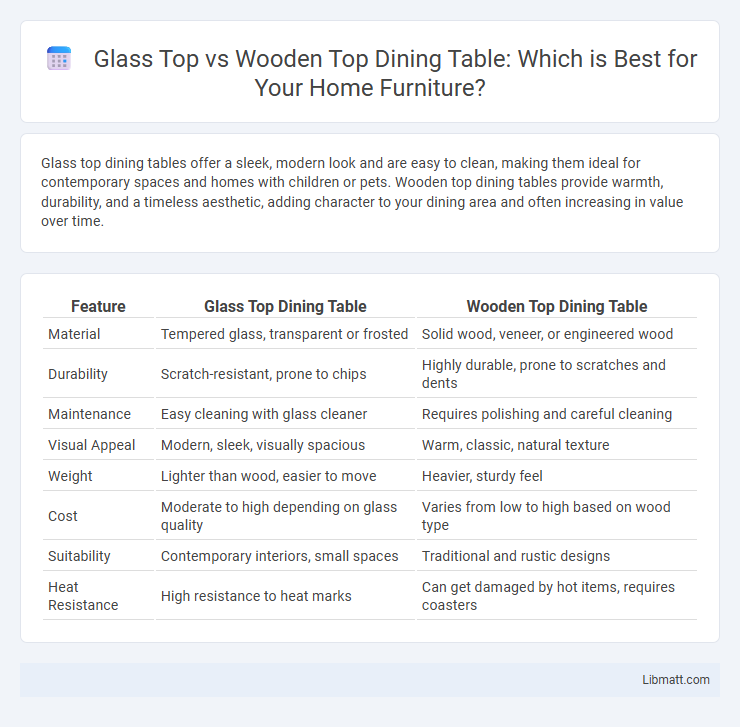Glass top dining tables offer a sleek, modern look and are easy to clean, making them ideal for contemporary spaces and homes with children or pets. Wooden top dining tables provide warmth, durability, and a timeless aesthetic, adding character to your dining area and often increasing in value over time.
Table of Comparison
| Feature | Glass Top Dining Table | Wooden Top Dining Table |
|---|---|---|
| Material | Tempered glass, transparent or frosted | Solid wood, veneer, or engineered wood |
| Durability | Scratch-resistant, prone to chips | Highly durable, prone to scratches and dents |
| Maintenance | Easy cleaning with glass cleaner | Requires polishing and careful cleaning |
| Visual Appeal | Modern, sleek, visually spacious | Warm, classic, natural texture |
| Weight | Lighter than wood, easier to move | Heavier, sturdy feel |
| Cost | Moderate to high depending on glass quality | Varies from low to high based on wood type |
| Suitability | Contemporary interiors, small spaces | Traditional and rustic designs |
| Heat Resistance | High resistance to heat marks | Can get damaged by hot items, requires coasters |
Introduction: Glass Top vs Wooden Top Dining Tables
Glass top dining tables offer a sleek, modern aesthetic with easy-to-clean surfaces that resist stains and spills, making them ideal for contemporary homes. Wooden top dining tables provide a warm, timeless appeal with natural textures and durability, often enhancing the cozy atmosphere of any dining space. When choosing between glass and wooden tops, consider your lifestyle, maintenance preferences, and the overall design vibe you want to create in your dining area.
Aesthetics and Style Comparison
Glass top dining tables offer a sleek, modern aesthetic with a reflective surface that enhances light and creates a sense of openness, making them ideal for contemporary and minimalist interiors. Wooden top dining tables provide a warm, natural, and timeless charm with rich textures and grains that add character and coziness, fitting well with rustic, traditional, or farmhouse styles. The choice between glass and wood tops significantly influences the dining room's ambiance, balancing elegance and warmth according to design preferences.
Durability and Longevity
Glass top dining tables offer excellent resistance to scratches and stains, maintaining a sleek appearance over time with minimal maintenance. Wooden top dining tables provide robust durability, especially when crafted from hardwoods like oak or maple, with the ability to be refinished to extend their lifespan. The longevity of wooden tables depends on proper care and protection from moisture, while tempered glass tops offer long-lasting durability but can be prone to chipping or cracking under heavy impact.
Maintenance and Cleaning
Glass top dining tables require regular wiping with a gentle glass cleaner to prevent smudges, fingerprints, and watermarks, making them easy to maintain but prone to visible dirt. Wooden top dining tables need periodic dusting and occasional polishing or waxing to protect the wood finish from scratches, stains, and moisture damage, demanding more careful and consistent upkeep. Both materials benefit from using coasters and placemats to extend the life of the surface by minimizing direct contact with hot or wet items.
Cost and Affordability
Glass top dining tables generally have a higher price due to the cost of tempered glass and the craftsmanship required, making them less affordable for tight budgets. Wooden top dining tables offer a broader range of prices, from budget-friendly options using engineered wood to premium hardwood varieties, providing more flexibility in cost. Your choice will depend on balancing aesthetic preferences with the available budget and desired durability.
Safety Considerations
Glass top dining tables require tempered or safety glass to reduce the risk of shattering and injury, making them suitable for families with children when properly manufactured. Wooden top dining tables offer greater durability and less risk of sharp edges or breakage, providing a safer option for high-traffic households. Proper maintenance of both materials, such as regular inspections for cracks in glass or splinters in wood, enhances overall dining table safety.
Functionality and Daily Use
Glass top dining tables offer a sleek surface that is easy to clean and resistant to stains, making them ideal for households with frequent meal preparation and spills. Wooden top tables provide durability and a warm aesthetic, with the potential to withstand daily wear and minor scratches through refinishing. The choice between glass and wood hinges on lifestyle needs, as glass excels in modern maintenance ease while wood supports longevity and a cozy ambiance.
Design Versatility and Customization
Glass top dining tables offer sleek, modern appeal with versatile design options, easily complementing minimalist, contemporary, or industrial decor styles. Wooden top dining tables provide rich customization through various wood types, finishes, and carvings, allowing you to tailor the piece to traditional, rustic, or eclectic interiors. Your choice depends on whether you prefer the reflective elegance of glass or the warm, textured character of wood for enhanced customization.
Environmental Impact
Glass top dining tables often have a higher carbon footprint due to energy-intensive manufacturing and lower recyclability compared to wooden tops, which can be sourced from sustainable forestry and recycled more easily. Wooden tables made from certified sustainable wood reduce deforestation concerns and support carbon sequestration during the tree's growth phase. Choosing wooden tops for your dining room can minimize environmental impact through renewable materials and longer lifecycle potential.
Final Verdict: Choosing the Best Dining Table Top
Glass top dining tables offer sleek aesthetics and easy maintenance, making them ideal for modern spaces and quick cleanups. Wooden top dining tables provide warmth, durability, and timeless appeal, often enhancing traditional and rustic interiors. The best choice depends on lifestyle, design preferences, and maintenance priorities, with glass suited for contemporary minimalism and wood favored for comfort and longevity.
glass top vs wooden top dining table Infographic

 libmatt.com
libmatt.com